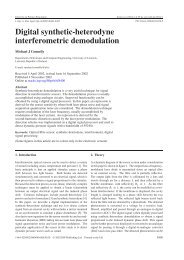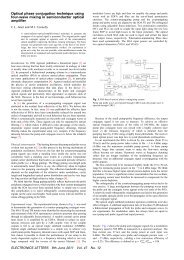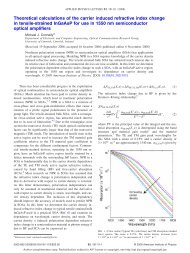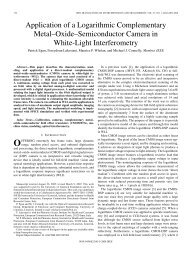Laser Doppler Vibrometry System using the Synthetic-Heterodyne ...
Laser Doppler Vibrometry System using the Synthetic-Heterodyne ...
Laser Doppler Vibrometry System using the Synthetic-Heterodyne ...
Create successful ePaper yourself
Turn your PDF publications into a flip-book with our unique Google optimized e-Paper software.
CSNDSP08 - 134 - Proceedingsand analysis are presented and in section IV someconclusions are presented.II. LDV SYSTEMA schematic diagram of <strong>the</strong> LDV system isschematically shown in Fig. 1 and <strong>the</strong> experimental setupis shown in Fig. 2. The light from a laser diode iscollimated and illuminates a reflection holographic opticalelement (RHOE) and a transmissive HOE. The RHOEreconstructs <strong>the</strong> beam of light originally scattered from adiffusely reflecting surface, to act as a reference beam.The RHOE efficiency of 50% allows <strong>the</strong> transmission of<strong>the</strong> remaining incident light. The reflected light from <strong>the</strong>vibrating object is efficiently transmitted through <strong>the</strong> twoHOEs and interferes with <strong>the</strong> reference beam at <strong>the</strong>CMOS camera. More details on <strong>the</strong> HOEs can be found in[9]. The detected light signal is <strong>the</strong>n processed by <strong>the</strong>camera DSP to retrieve <strong>the</strong> vibration signal.III.SYNTHETIC-HETERODYNE INTERFEROMETRICDEMODULATION THEORYThe detected photocurrent from a two-beaminterferometer can be written asI() t A[ 1 + V cosθ( t)]= (1)The constant A is proportional to <strong>the</strong> optical power of <strong>the</strong>detected light beams and <strong>the</strong> mixing efficiency of <strong>the</strong>detector and V is <strong>the</strong> interferometer visibility. θ (t)is<strong>the</strong> phase difference between <strong>the</strong> arms of <strong>the</strong>interferometer. A typical plot of (1) is shown in Fig. 3.The sensitivity of <strong>the</strong> interferometer is maximized when<strong>the</strong> mean phase difference between <strong>the</strong> detected lightbeams is an odd integer multiple of π/2. When this is <strong>the</strong>case <strong>the</strong> interferometer is said to be operating inquadrature.drive current. The resulting laser frequency modulation isconverted to phase modulation by <strong>the</strong> non-zero cavity pathdifference of <strong>the</strong> interferometer. It can <strong>the</strong>n be shown that[10]I( t) A{ 1 + V cos[ C cos( ω0t)+ φ(t)]}= (2)where φ(t)contains <strong>the</strong> signal of interest and slowenvironmental effects. The most important effect istemperature variations that cause refractive index changesin <strong>the</strong> interferometer, which leads to <strong>the</strong> interferometerdrifting in and out of quadrature. If <strong>the</strong> single-mode laserdiode is modulated with a small-signal sinusoidal currentof amplitude I m<strong>the</strong>ndνC ≈ 2πImτdI(3)dν dI and τ are <strong>the</strong> differential of <strong>the</strong> laserwhereoptical frequency with respect to <strong>the</strong> applied current and<strong>the</strong> average time difference between <strong>the</strong> interferometerarms respectively. Typical values of dν dI are in <strong>the</strong>range of a 100s of MHz/mA for conventional Fabry-Perotlaser diodes [11] . (2) can be expanded into a series ofsidebands at integer multiples of ω 0that contain <strong>the</strong>signal of interest φ (t). In syn<strong>the</strong>tic-heterodynedemodulation, <strong>the</strong> first two sidebands of (2) are mixedwith in-phase local oscillators at ω0and 2ω0and lowpassfiltered to giveSS12= AVJ1(C)sinφ(t)= AVJ ( C)cosφ(t)2(4)where J1and J2are Bessel functions of <strong>the</strong> first kind oforder one and two respectively. Taking <strong>the</strong> timederivatives of S1and S2givesSS34= AVJ1(C)& φ(t)cosφ(t)= −AVJ( C)& φ(t)sinφ(t)2(5)Figure 3. Typical two-beam interferometer transfer function.Multiplying S1by S4and S2by S3givesSS5622( AV ) J1(C)J2( C)& φ(t)sinφ(t22( AV ) J ( C)J ( C)& φ(t)cosφ(t)= −=12)(6)In <strong>the</strong> syn<strong>the</strong>tic-heterodyne technique a sinusoidalmodulation with frequency ω0and amplitude C isimposed on <strong>the</strong> interferometer. In this work <strong>the</strong>modulation is carried out by modulating <strong>the</strong> laser diodefrequency via sinusoidal amplitude modulation of <strong>the</strong> laserSubtracting S5from S6givesS o2( AV ) J C)J ( C)dφdt= (7)1 ( 2






